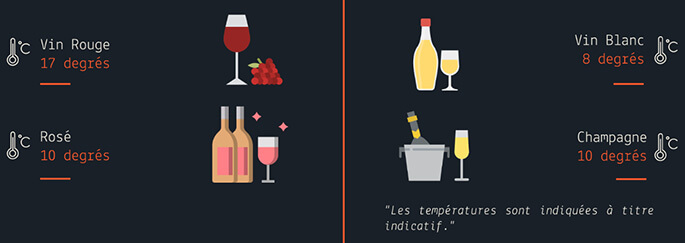About wine [Infographie]

What serving temperature for wines?
Serving a white wine too cold alters its aromas. The wine fades. Serving a red wine at too high a temperature upsets the tannins, which become drier. As a result, you get the unpleasant sensation of a "raspy" wine.
We used to say that red wine should be left at room temperature for a few hours before drinking, but this is no longer true. We heat our homes far too much to hope to achieve the ideal tasting temperature for a good Bordeaux or Chianti, for example.
If we were to draw up a generic list of wine drinking temperatures, we could sum it up as follows:
Red wines :
White wines :
Rosé wines :
Bubbles:
|
Please note, however, that these temperatures are given as a guide only, and may vary depending on whether you're drinking a Beaujolais or a Chinon. If in doubt, ask your wine merchant for personalized advice tailored to the wines you're drinking.
Make sure you enjoy your wine at the right temperature to ensure it delivers its best aromas.

In what order is wine served?
Wine is an integral part of French gastronomy. So it's a good idea to serve it "lightest to darkest". Just as a cheesemonger would tell you to start the platter with the mildest cheese (and not the Roquefort!), a sommelier will advise you to servewhite wines before reds, and young wines before old.
Today's meals don't necessarily follow this order, and it's not uncommon for a red wine to be served as an aperitif. The risk is that your palate won't be able to detect the true aromas and qualities of a sweeter wine if you start with a full-bodied one.
Wine by the glass can be served according to its strength. Lively, fresh wines can be used to start a meal, while sweet wines can be used to finish it. French-style meals are generally served from the least to the most powerful dishes. Composing the best "food/wine" pairing, such as fish with white wine, is traditionally a safe bet.
How to store your wine?
All wines can be kept for at least 1 year, even wines that are not Grand Cru. On the other hand, if you want to keep your wine for 2 to 10 years, opt for wines with more tannins. Exit table wines.
For ageing, i.e. cellaring for 10 years or more, Grand Cru wines are more suitable. The wine's color is another indicator of aging. Purple or crimson highlights characterize a young red wine. As the years go by, the wine's color evolves towards a tile-red hue.
With such a long shelf-life, your bottles need to be stored in the best possible conditions. Ageing wine cellars are perfect for your vintages.

What does decanting mean?
If deposits become visible in a bottle of wine, then decanting is essential. Decanting separates the deposit in the bottle while aerating the wine. Decanting involves pouring the wine into a decanter to separate the wine from the sediment. Decanting is performed as follows:
- Place a light source under the neck to illuminate the wine's passage, and pour gently into a decanter or with a pouring basket (for older wines).
- When the first particle of sediment appears at the neck, stop pouring.
It's best to decant two hours in advance for a young wine, one hour for a mature wine and a few minutes for a risky wine.
How to choose the right glass?
The best glass is one with a wider base that closes more tightly at the top. This "tulip" shape allows aromas to develop more fully in the glass, concentrating them towards the nose. The "INOA" tasting glass has all the characteristics of the ideal glass:
- Colorless to fully appreciate the wine's color and texture
- Stemmed to avoid heating the wine with your hand (and yes, the glass is held by the stem, not by its round shape, which fits the palm of your hand so well!)
- Tightened at the neck to better capture all the wine's aromas.
- Suitable for all types of wine in all situations, whether white, red or even Champagne.

How to store an opened bottle?
It often happens that you open a bottle of wine and don't finish it during the meal. This raises the question of how best to preserve the wine until the next occasion of consumption. The aim, of course, is to avoid deterioration.
There are a few simple steps you can take to prevent air oxidation (and thus the unalterable deterioration of wine quality):
- Replace the cork in the right direction and place the wine in the cellar. Depending on the wine, this will keep it for 1 or 2 days after opening;
- New systems such as vacuum pumps, which extract oxygen from inside the bottle, can help you keep your wine longer;
- In addition, there are now wine cellars with integrated air suction systems. At La Sommelière, the LS38A service cellar holds up to 3 bottles in a vertical position, and uses a cork and pump specially designed for wine toextract oxygen (O2) and preserve the wine for several days! Your wines are thus at the right temperature in your cellar, ready to be consumed in the next few days without losing any of their organoleptic qualities. It's an ingenious cellar that drastically reduces waste and the number of bottles emptied into the sink.
- As for sweet wines, they can be kept for several days without any problem, and good-quality Champagne can be kept for two or three days in a cool place (or cellar!)
Did you enjoy this article? Don't hesitate to leave your comments, we'll be delighted to read them.






